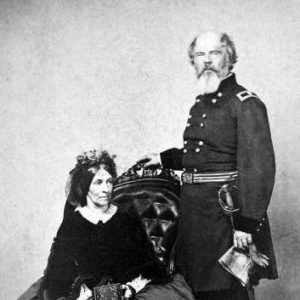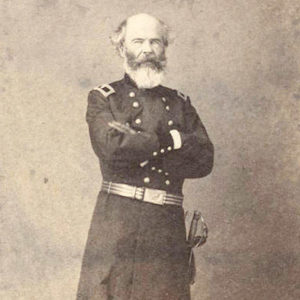calsfoundation@cals.org
Napoleon Bonaparte Buford (1807–1883)
Napoleon Bonaparte Buford served as a general officer in the Union army during the Civil War, including for several years as the commander of the District of Eastern Arkansas.
Born in Woodford County, Kentucky, on January 13, 1807, to John and Nancy Buford, Napoleon Bonaparte Buford grew up in the state. His father was a member of the Kentucky legislature and later served in the Illinois legislature. In the 1830 federal census, his father was listed as owning forty-five slaves, evidence that the family was part of the landed elite in Kentucky.
Buford graduated from the United States Military Academy at West Point in 1827. His class included Leonidas Polk, who became the first Episcopal bishop to serve Arkansas. After receiving his commission, Buford attended law school at Harvard College before returning to West Point as an instructor. He resigned his commission in 1835 and entered private business. Returning to Kentucky, Buford worked as an engineer on the Licking River and moved with his family to Illinois in 1843. He had previously conducted a survey of the Mississippi River near Rock Island, Illinois, for the army in 1828. Working by this time as an engineer, president of a railroad, and a banker, Buford did not serve in the Mexican War.
Buford’s bank failed as the Civil War began, an occurrence that he blamed on the bonds that his institution held for a number of southern states. Buford entered service as a colonel of volunteers with the Twenty-Seventh Illinois Infantry. Organized at Camp Butler near Springfield, Missouri, in August 1861, the regiment first saw action at the Battle of Belmont, Missouri, in November of that year. During the Battle of Island No. 10, Buford commanded a brigade consisting of his regiment and two additional infantry regiments and two artillery batteries.
Receiving a promotion to brigadier general on April 15, 1862, Buford led a brigade at both the First and Second Battles of Corinth. Ordered to Washington DC, Buford served on the court-martial of Major General Fitz John Porter for several specifications including disobeying a lawful order and misconduct in front of the enemy. The court found Porter guilty. More than a decade after the war, however, Porter’s actions were justified in a report completed by a special commission, his sentence was commuted, and his commission was restored.
Buford returned to active service that spring, taking command of the garrison at Cairo, Illinois. Ulysses S. Grant disliked Buford, saying, “He would scarcely make a respectable Hospital nurse, if put in petticoats, and he is unfit for any other Military position. He has always been a dead weight to carry becoming more burthensome with his increased rank.” This low opinion likely impacted Buford’s chances at obtaining a posting in the field. By June 1863, Buford’s command at Cairo had been reduced to a single infantry regiment, and the fort at Cairo was under threat of being flooded by high water.
Appointed on September 12, 1863, to command the District of Eastern Arkansas headquartered at Helena (Phillips County), Buford moved down the river from Cairo to assume his post. Reports filed the following month place just over 3,600 troops under Buford’s command. At Helena, Buford reported on his efforts to defeat the small bands of guerrillas in the surrounding countryside with occasional engagements against regular Confederate troops. Buford commanded the district in the summer of 1864 when Brigadier General Joseph O. Shelby led his Confederate cavalry brigade across eastern Arkansas, capturing and sinking the USS Queen City and attacking isolated Federal outposts.
Buford was tasked with defending Helena with few resources, as it was well removed from the major theaters of war. He spent much time requesting additional troops or support from gunboats to protect the city from Confederate cavalry. A report from January 31, 1864, listed his total command as portions of the Second, Third, and Fourth Arkansas Colored Infantry Regiments; the First Iowa Colored Regiment; the Third Louisiana Colored Artillery; two white infantry regiments, and one white cavalry regiment. Another report from the next month put his total strength at 3,333, including sick and furloughed soldiers. With this small force, Buford tried to regulate trade in eastern Arkansas to prevent Confederate forces from receiving war materials but was often unable to do much with his small force. He also worked to protect the numerous freedmen working on the government-leased plantations in eastern Arkansas. Buford consistently requested more white troops be sent to him in Helena, but his command was never substantially reinforced due to the pressing need for troops in other places.
Buford reported on the Skirmish at Lamb’s Plantation, where Confederate soldiers killed unarmed civilians and soldiers. He also wrote a letter asking that the interior of the state be abandoned to Confederate control while strongpoints were constructed along the Mississippi River to protect the ability of Federal forces to use the waterway while preventing Confederates from trading across the stream. While he commanded the post at Helena, Buford asked the Society of Friends to establish an orphanage for formerly enslaved children in the city. This eventually grew into Southland College.
Buford was removed from command on March 9, 1865, and replaced by Major General Alexander McCook. With the war coming to a close, McCook commanded the District of Eastern Arkansas for only about six weeks before being posted to the west in anticipation of future conflicts with Native Americans. Buford’s removal came as a direct order from Ulysses Grant, and he did not receive another command, returning to his home in Illinois instead. On May 27, 1865, Buford was ordered to report to Newburyport, Massachusetts. Leaving active service that August, Burford received a brevet promotion to major general in 1867 in recognition of his service.
Buford was married twice. He married Sarah Childs of Pittsfield, Massachusetts, in 1832, while he was on active service in the army; the couple had at least three sons. Sarah died in 1858 in Rock Island. Buford married Mary Ann Greenwood in 1860. The couple met in Illinois, where Greenwood had moved after the death of her first husband. When posted to Helena, Mary Ann accompanied Buford to the city. They remained married until his death in 1883. She died in 1903.
After the war, Buford worked as an inspector on the Union Pacific Railroad and also served briefly as an Indian commissioner. He died on March 28, 1883, and is buried in Chippiannock Cemetery, in Rock Island.
Buford’s younger half brother, John Buford, also served as a brigadier general in the Union army. He was instrumental in fighting on the first day at the Battle of Gettysburg and received a promotion to major general on his deathbed. Their cousin, Abraham Buford, served as a brigadier general in the Confederate army.
For additional information:
Bullock, Helen Duprey. “The Robert Todd Lincoln Collection of The Papers of Abraham Lincoln.” Quarterly Journal of Current Acquisitions 5, no. 1 (1947): 3–8.
Glass, Tom. “Union Wives and Their Generals.” Military Images 34, no. 2 (2016): 35–43.
Harrison, Lowell H. “Kentucky Born Generals in the Civil War.” Register of the Kentucky Historical Society 64, no. 2 (1966): 129–160.
Kennedy, Thomas C. “The Rise and Decline of a Black Monthly Meeting: Southland, Arkansas, 1864–1925.” Arkansas Historical Quarterly 50 (Summer 1991): 115–139.
The War of the Rebellion: A Compilation of the Official Records of the Union and Confederate Armies. Series 1, Vols. 34, 41, 48. Washington DC: Government Printing Office, 1893.
David Sesser
Southeastern Louisiana State University
 Civil War through Reconstruction, 1861 through 1874
Civil War through Reconstruction, 1861 through 1874 Military
Military Napoleon and Mary Ann Buford
Napoleon and Mary Ann Buford  Napoleon Buford
Napoleon Buford 




Comments
No comments on this entry yet.